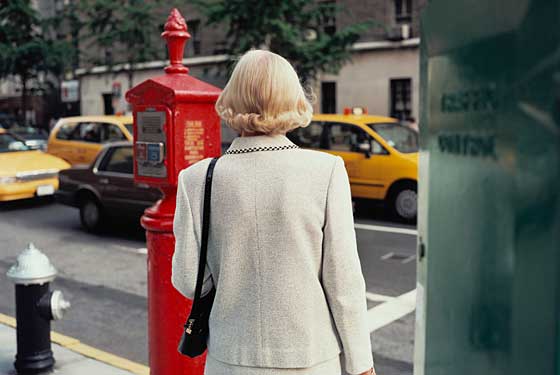 |
(Photo: Mitch Epstein/Gallery Stock) |
So I was at a party on Fifth Avenue—one of those grand old apartments that represented the apex of the late-eighties Louis Quinze style. It was way over the top, and yet the vision was so perfectly realized: the quality of the furniture and the art, the proportions of the rooms, and the unity of the vision, such that I couldn’t help being blown away. It’s not my style, but I have to say it was really awe-inspiring. If the Landmarks commission ever decides to preserve interiors, this one should be at the top of the list. It was like a monument not only to a certain period of French décor but also to a recent period of haute Upper East Side life and Manhattan wealth. The dinner party was being given in honor of the Italian writer Alain Elkann. Along with Robert Hughes, who’d come in from Westchester, I was one of the few people at the gathering who’d traveled more than a few blocks that evening to attend the party.
“Where do you live?” one of the guests asked politely, trying to place me, as if I didn’t seem quite local. “The Village,” I said. There was a chorus of oohs and aahs and what-hos around the room. Then, you could have knocked me over with a feather duster, John Gutfreund, the former chairman of Salomon Brothers, said, “I want to move to the Village, but my wife won’t hear of it.”
“Me too,” said Jacqui Safra, scion of the Lebanese banking family and longtime consort of producer Jean Doumanian. “I want to move downtown, but Jean won’t let me.” (Safra and Doumanian have since put their Upper East Side townhouse on the market.) The topic became general, and debate was joined. All around me, Upper East Siders of long standing—Black Card–carrying members of the tribe that was once called the 400—followed the lead of these two Über-uptown guys and began to talk about their recent adventures downtown, about friends who’d actually made the move, about lofts with their vast expanses of wall on which to hang paintings, about how … fun it was down there. And about how expensive it had become, the last being, in this circle if I read them right, a term of approbation.
In fact, this past spring, Forbes announced that Tribeca’s 10013 was the most expensive Zip Code in Manhattan—the twelfth most expensive in the nation, followed by 10007 to the south (No. 19) and Soho’s 10012 (No. 31). Venerable 10021, which includes most of the choicest cuts of the Upper East Side, the default Zip for generations of cotillion and benefit invitations, received a national rank of No. 255. (No. 1 was Sagaponack, the former stepchild of the Hamptons. Apparently, potatoes are way up.) As recently as 1990, before the dot-com and telecom booms, 10021 was the wealthiest Zip Code in the country. The survey was based on median home-sales prices. Meanwhile, the brokerage Citi Habitats reported that Tribeca and Soho are also the most expensive neighborhoods in which to rent (average rent: $3,718 a month) followed closely by Chelsea ($3,041) and the West Village. The Upper East and Upper West Sides are bargains by comparison, with average rents near $2,500. If we broke down the figures for the real tenderloin on the Upper East Side, the three avenues between Lexington and Central Park between 59th and 96th, the real silk-stocking district, the numbers would go higher. But still, it’s hard to deny that the Upper East Side isn’t the ne plus ultra that it used to be.
Last year, I started dating an Uptown Girl, and I’ve been shuttling back and forth between the Village and the Upper East Side ever since, pondering the cultural differences between our respective tribes as well as the question of geographical determinism. Is Zip Code destiny anymore? One night, I would accompany her to the black-tie Rita Hayworth Ball; the next night, we’d have dinner at the Spotted Pig and head up to Chelsea for a nightcap and a dance at Marquee. At times, these worlds seemed bizarrely heterogeneous; but then again, Patrick McMullan was snapping pictures at Marquee or at the Waldorf, and Donald Trump was likely to be standing next to you at either venue, so it was possible to see prosperous Bloombergian Manhattan as a melting pot of sorts, for better or worse, rather than the Balkan metropolis of disparate, geographically determined tribes that I’d moved to 25 years ago. This summer, after we became engaged, these questions took on a practical urgency as we had to choose between the two realms—if they were two realms—at least in terms of a mailing address.